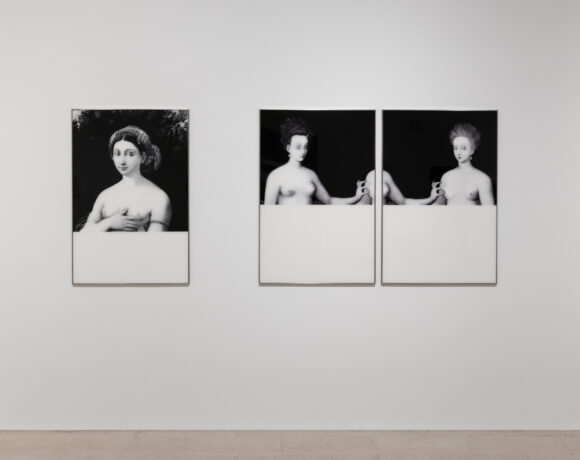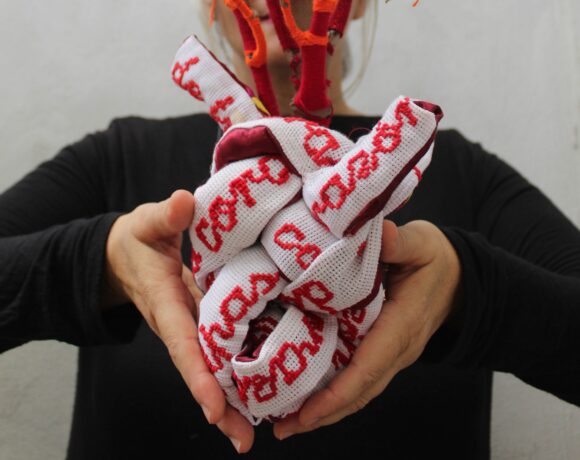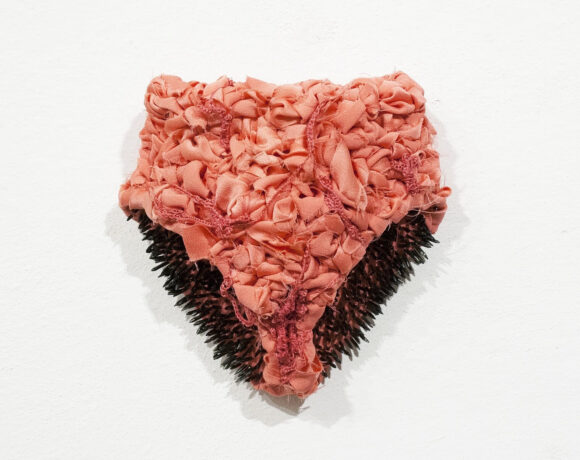The prestigious Max Mara Prize for Women, established in 2005 by Max Mara, Maramotti Collection, and Whitechapel Gallery, and awarded every two years to female artists not yet present on the contemporary scene with a solo-show, is now in its eighth edition. Winner of the award for the period 2019-2021, is the British artist Emma Talbot (1969, Stourbridge, Worcestershire, UK) who has long been dedicated to art-teaching and whose work distinctly emerged at the time of the pandemic for its social impact, with the installation the Four Visions for a Hopeful Future, presented on the occasion of the international women’s day in the context of CIRCA- Piccadilly Lights in March 2021.
Along the same lines, for the Max Mara Prize for Women, Talbot’s proposal draws inspiration from the notable painting by Gustav Klimt, The Three Ages of Woman (1905) belonging to the collection of the National Gallery of Modern Art in Rome, and particularly on the figure of the older woman standing from the background of the scene in a pose of suffering and dishonor. From studies of this pictorial representation conducted by the artist in a residency began in June 2021, Talbot’s project aims at animating this figure through an anachronistic journey that confronts itself with the Herculean myths and more widely with classical mythology of which many Italian museums and institutions are custodians, in order to overturn the stereotypes on this figure in the modern age and reconstruct the role of women in society in an interdisciplinary and transnational discourse.
If, as Talbot says, “this award comes at a crucial moment that seems incredibly timely to me”, the artist’s project is welcomed with enthusiasm and interest by the promoting commission. Dwelling on how the artist’s immersion in the Italian culture can benefit both the community and the artist’s vision, Sara Piccinini, director of the Maramotti Collection, declares: “Emma Talbot’s project takes mythology and art history as a starting point to explore new principles and practices that could help build a future society”. On the other hand, observing Talbot’s visionary poetics, Iwona Blazwick, director of the Whitechapel Gallery, comments: “Emma Talbot creates radiant drawings and polychrome sculptures on an epic scale; and she combines word and image to express the lyricism and pain of subjectivity “. Finally, emphasizing the artist’s contribution as regards the reinterpretation of textile techniques, Luigi Maramotti, president of Max Mara argues: “Emma Talbot has created a very original project which, hopefully, will leverage the incredible potential that ‘Italia offers when it comes to deepening the history of art, textile techniques and the diversity of the territories: all crucial elements for its future endeavors”.
Six months have passed since the announcement of the Max Mara Prize for Women residency – organized by the Maramotti Collection, with the collaboration of various tutors and institutions in Italy – and on 6 December 2021, an artist lecture held at the British School in Rome, reflected on the research conducted in these months of residency in dialogue with Valentino Nizzo, director at the National Museum Etrusco of Villa Giulia, and moderated by Abigail Brundin, director of the institute. It was the occasion to outline the main features of Emma Talbot’s practice starting from a reflection on drawing to further elaborate a series of mythological visions that draw lymph from classical mythology. This is demonstrated by the experience of residency at the Modateca Deanna in Reggio Emilia, where the artist conducts research on materials, colors, techniques – among which that of inlay for the creation of jacquard motifs stands out – which we will find in the works endings.
The attention to the landscape was at the center of the artist’s interest during a residence held in the summer months in Catania with the guide of the artist Rosario Sorbello when Talbot visited ancient archaeological sites and volcanic soils and which suggested her the representation of a landscape that is as sustainable as archetypal as seen in the background of her works.
At the height of this journey, a residency conducted at the British School in Rome allowed the artist to develop her own personal vision of female figures through classical mythology. With the wise guidance of Director Valentino Nizzo, Talbot here had the opportunity to come into contact with archaeological findings and furnishings of ancient Greek, Etruscan and Roman ceramics, all powerful vectors for classical mythology by particularly been interested in the values and virtues evoked by the Herculean myths in a feminine and contemporary guise. The result is an anachronistic journey conducted through the reinterpretation of literary and visual tropes as the culmination of Emma Talbot’s practice and thought, intellectual premises to the two prestigious solo exhibitions to be held at the Whitechapel Gallery and the Maramotti Collection in 2022.
Info:
 Emma Talbot, portrait in the artist’s studio, pictured with When Screens Break, 2020. Photo: Thierry Bal
Emma Talbot, portrait in the artist’s studio, pictured with When Screens Break, 2020. Photo: Thierry Bal
 Emma Talbot, Do You See Yourself Projected? Art Night commission Acrylic on Silk Dimensions variable. Photo: Thierry Bal, courtesy the artist
Emma Talbot, Do You See Yourself Projected? Art Night commission Acrylic on Silk Dimensions variable. Photo: Thierry Bal, courtesy the artist
 Emma Talbot, The Age of the Reaper, 2019. Group show Starhawk’s Backyard with Gijs Frieling and Derk Thijs Galerie Onrust Amsterdam, courtesy of Galerie Onrust
Emma Talbot, The Age of the Reaper, 2019. Group show Starhawk’s Backyard with Gijs Frieling and Derk Thijs Galerie Onrust Amsterdam, courtesy of Galerie Onrust
 Emma Talbot,The Future Exploded. Watercolour and gouache on khadi paper © Emma Talbot
Emma Talbot,The Future Exploded. Watercolour and gouache on khadi paper © Emma Talbot

She is interested in the visual, verbal and textual aspects of the Modern Contemporary Arts. From historical-artistic studies at the Cà Foscari University, Venice, she has specialized in teaching and curatorial practice at the IED, Rome, and Christie’s London. The field of her research activity focuses on the theme of Light from the 1950s to current times, ontologically considering artistic, phenomenological and visual innovation aspects.






NO COMMENT